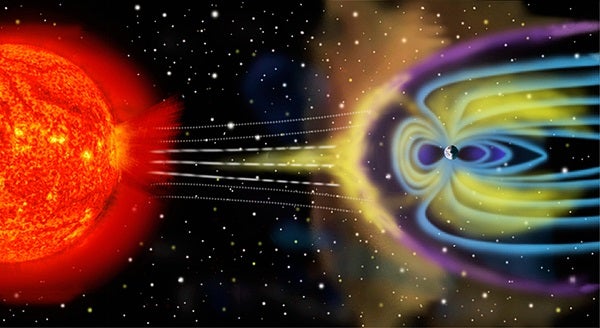Cosmic rays definitely have the most mysterious-sounding name in the universe, and they definitely live up to it. Even their history is intriguing.
Physicists first suspected their presence more than a century ago when they noticed that electrically charged laboratory objects slowly lost their charge for no apparent reason. Some electrical entity was apparently sneaking into the lab. That it came from the sky was not at all obvious until 1912, however, when Austrian physicist Victor Hess personally carried a charge-measuring instrument aloft in a balloon and found that charges increased as he ascended. Scientists assumed the culprit was some kind of invisible light from outer space, and thus was born the name cosmic ray.

Bringing the universe to your door. We’re excited to announce Astronomy magazine’s new Space and Beyond subscription box – a quarterly adventure, curated with an astronomy-themed collection in every box. Learn More >>.
It took until 1950 to prove that these were not electromagnetic beams but solid particles, even though the original name remains. Further studies showed that 89 percent are ordinary protons, while 10 percent are alpha particles — packages of two protons and two neutrons. The remaining 1 percent are electrons. All carry an electric charge and are thus influenced by magnetic fields.
A proton is a hydrogen atom’s nucleus. An alpha particle is a helium atom’s nucleus. Their cosmic-ray ratio matches the relative abundance of hydrogen and helium in the cosmos. It’s as if pieces of the universe are leaking in here. What doesn’t make sense is why electrons — far more abundant than the other particles — are so underrepresented in cosmic rays. But that’s the least of the mysteries.
A cosmic ray’s energy depends on its speed because a faster-moving object does more damage than a slower one. Cosmic rays arrive in an amazing range of speeds, and their power is expressed in electron volts, or eV. The most common, slower ones were created in the Sun and present little mystery. The higher-energy rays come from deep space. Then there are ultra-high-energy cosmic rays (UHECR), which are incredibly powerful and utterly baffling.
We on Earth are happily protected from nearly all cosmic rays by our atmosphere, and to a much lesser extent our planet’s magnetic field. Still, enough rays reach your body to deliver about 26 millirems of radiation exposure annually. You get an extra 5 millirems for every 1,000 feet (300 meters) higher your home is located. Cosmic rays really crank up their intensity in the upper troposphere at 35,000 to 42,000 feet (10,700 to 12,800m), which is why you receive an extra millirem for each thousand miles you travel by plane. It’s Frequent Flyer radiation. Thanks to their extended time in that high cosmic-ray environment, airline crews have a roughly 4.5 percent higher lifetime incidence of cancer; 23 cases in 100, instead of 22.
Astronauts — especially those leaving our protective magnetic field to venture to the Moon or maybe someday to Mars — face a fearsome cosmic-ray environment. In space, 5,000 cosmic rays tear through the human body each second. During a multiyear mission, this creates an enormously elevated risk of cancer and the wholesale destruction of brain neurons. Future Mars explorers had better start out with high IQs.
Shielding is problematical. To achieve the same cosmic-ray blockage we get from Earth’s atmosphere, you’d need to huddle beneath 16 feet (5m) of water or something with its mass equivalent.
While most cosmic rays have energies between 10 million and 10 billion eV, much more energetic ones arrive, too, and these are nearly inexplicable. Cosmic rays of more than 100 million trillion eV have been periodically detected since 1991, and these are 40 million times more powerful than anything we can create in a particle accelerator. A single such cosmic-ray particle can deliver a wallop equal to a tennis ball hitting you at 100 mph (160 km/h). They’re assumed to be protons traveling at just under the speed of light.
How does a proton with its substantial mass get accelerated that crazily? For years, the leading candidates for such UHECRs have been supernova remnants (see the Crab Nebula, number 9 on our list), but even these can’t explain truly ultra-high-energy particles. Recently, colliding galaxies like the Antennae (see number 45 on our list) have gained favor, but there are problems with this theory, too. Today, the leading candidates are AGNs, active galactic nuclei like the ones inside 10 percent of all galaxies, such as M82 (see object 47). It’s assumed their supermassive black holes play a pivotal role in slingshotting these projectiles to their fantastic speed and power. Recent measurements indicate a link between the direction of UHECRs and the location of AGN galaxies, although these are so nearly ubiquitous, it’s hard to say for sure.
Perhaps the most intriguing idea is that UHECRs materialize when theoretical dark matter particles hypothetically decay into high-speed proton pairs, one of which falls into a black hole while the other is shot across the cosmos. It’s a case where desperate, baffled astronomers are using the bizarre as evidence for the exotic.
Stay tuned.











